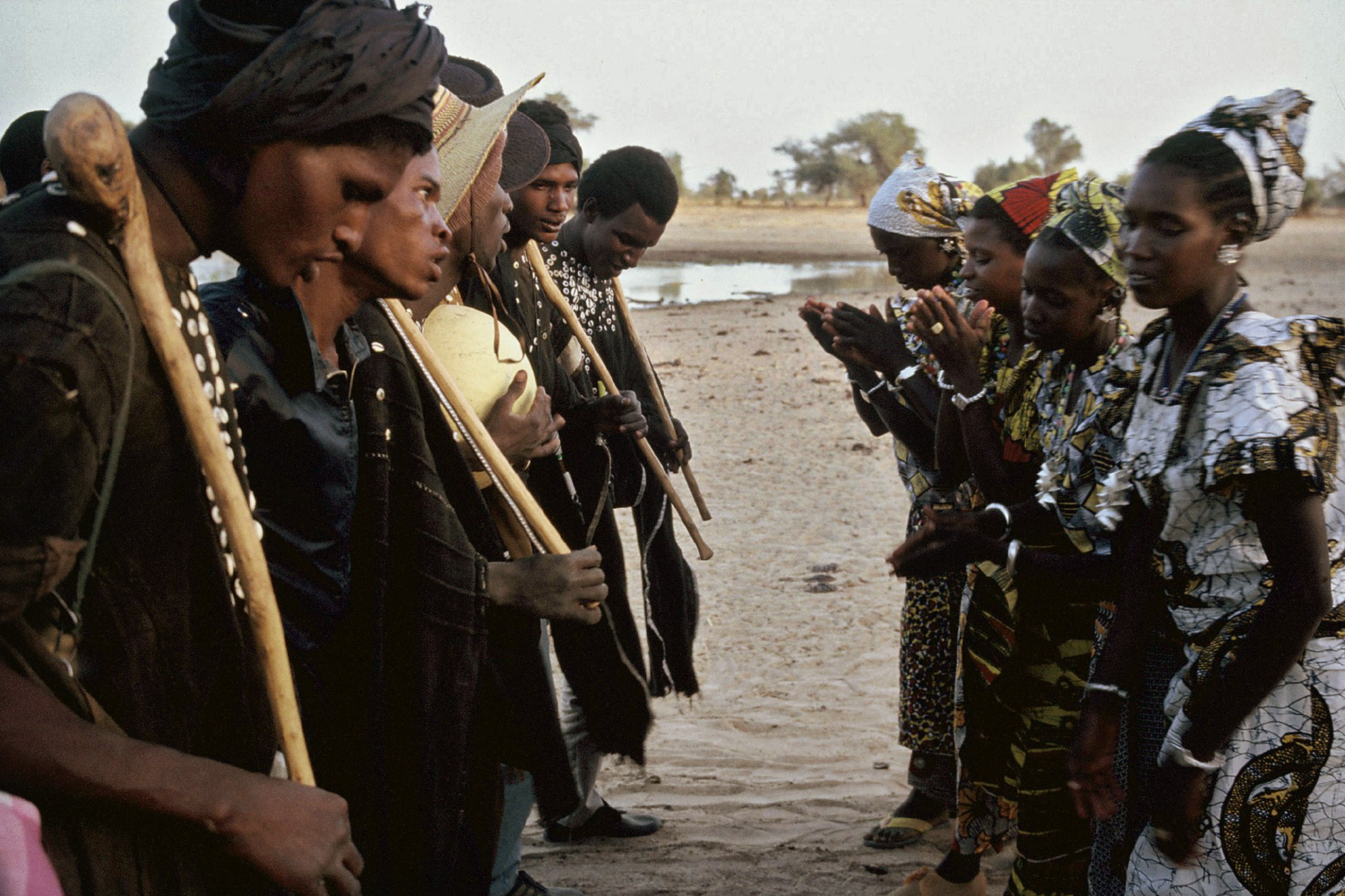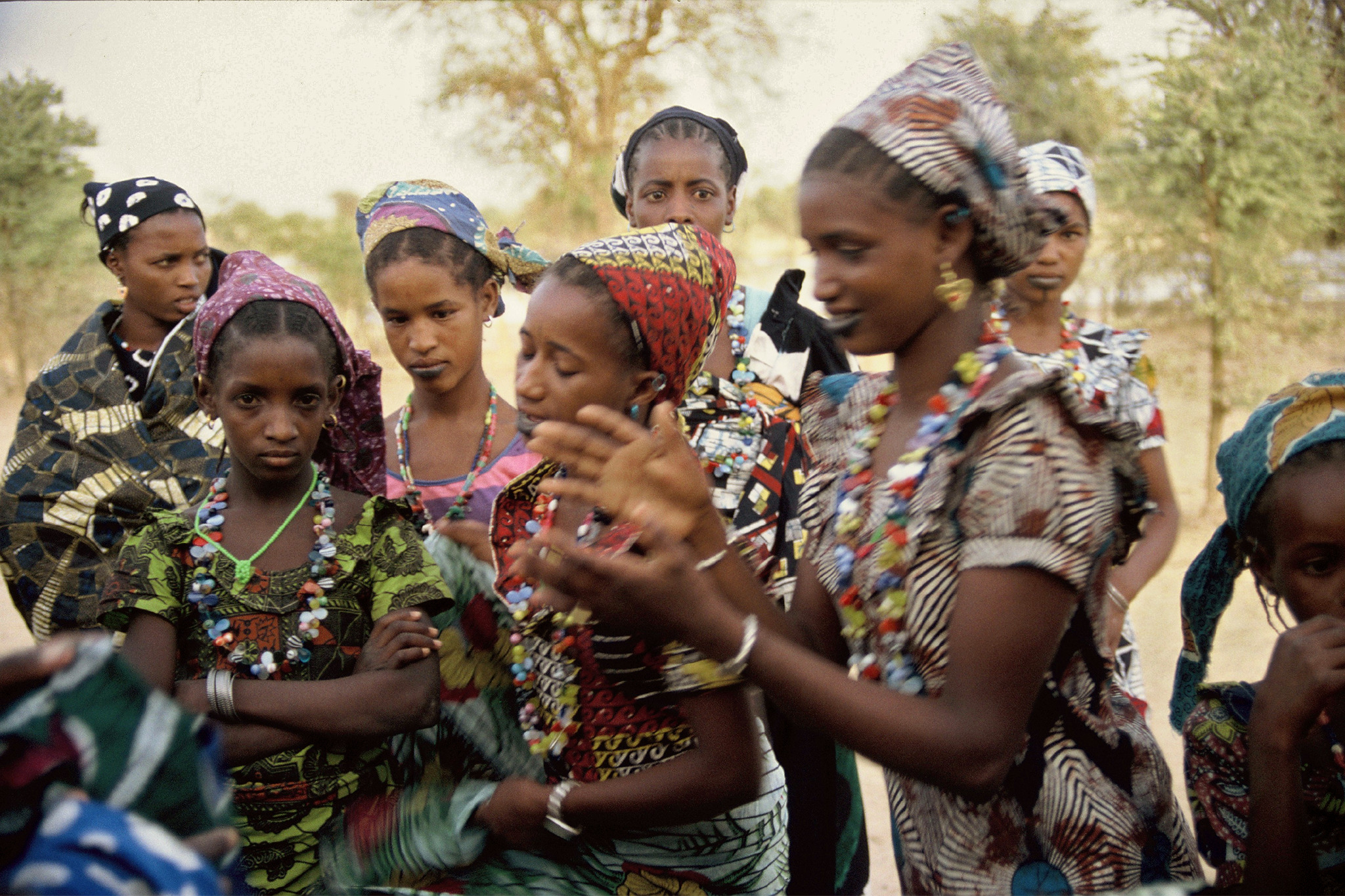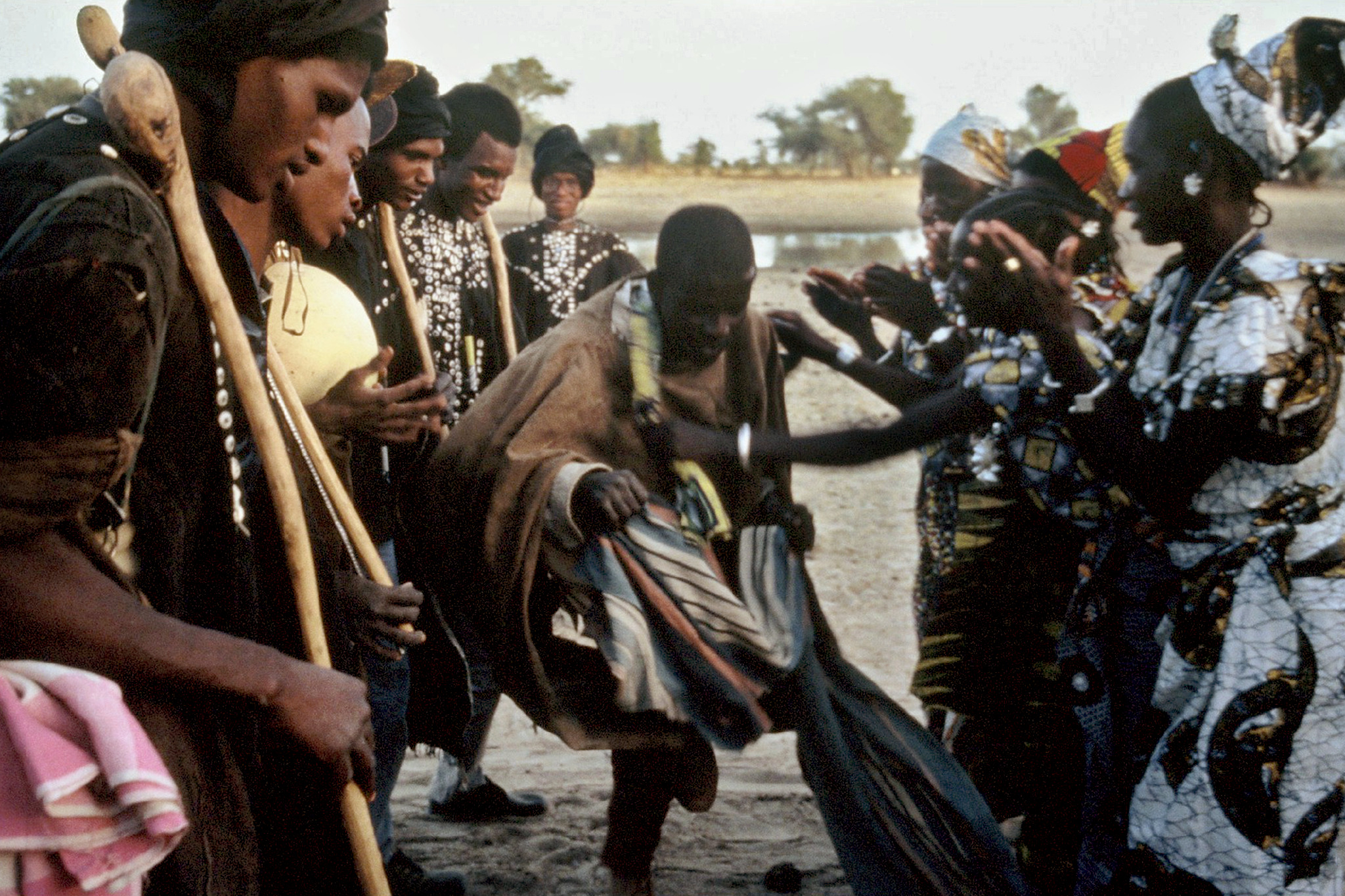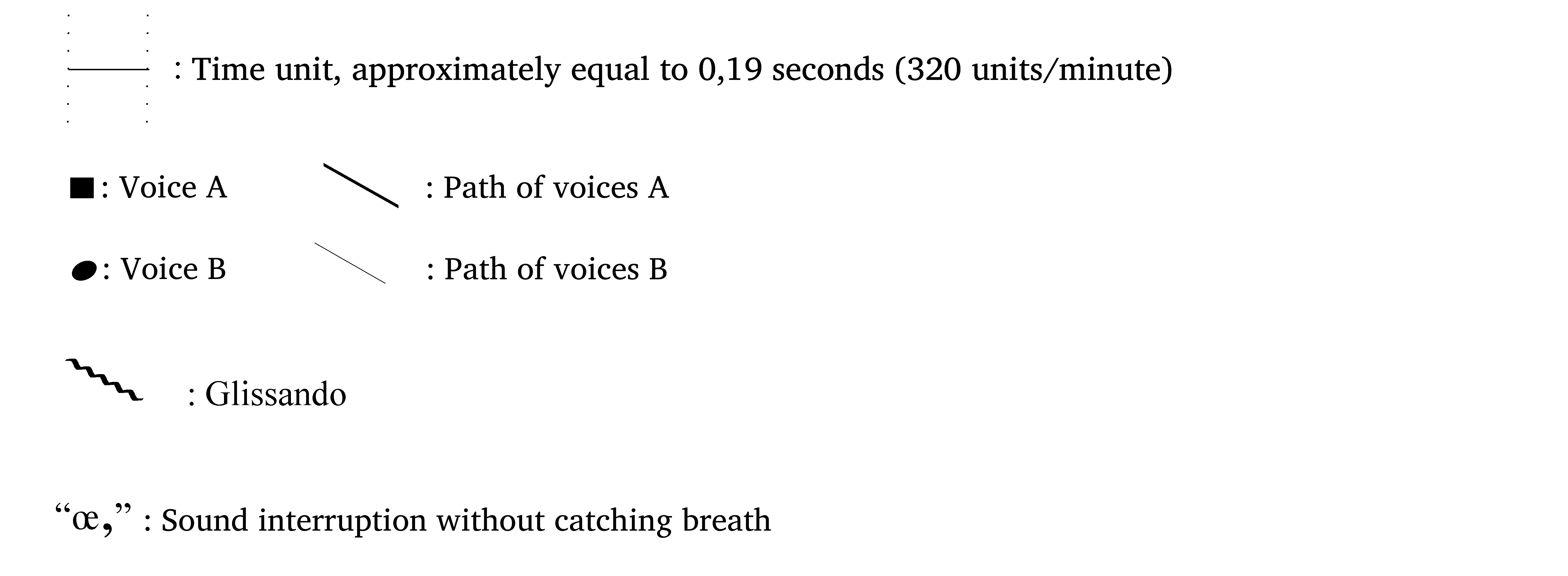|
How musical are the Fulɓe Jelgooɓe of Burkina Faso? The local category of "vocal power" Sandrine Loncke Originally published as “Le sens de la musicalité chez les Peuls Jelgooɓe du Burkina Faso. La catégorie de puissance vocale”. Journal des africanistes 69 (2), 1999, 67‑85. Draft translation: Sandrine Loncke, copy-editing: Jessica Sloan-Leitner. Abstract By drawing on a Fulɓe vocal music style, this article shows that to explore a musical genre as a whole, it is essential to take into account vernacular musical categories that are used to characterize a good performance. Not only does it allow for access to the performers' aesthetic concepts, but also permits revealing of the cultural representations that underlie their production. "Doohi of young people from Soboullé village isn't as good as the one of young people from Kouyé village, because in Soboullé, their voices lack power"[1]: These are the words used by a Jelgooji informer[2] (North Burkina Faso) to assess and compare vocal games called doohi performed by Fulɓe young herders of the region. This is not an isolated comment. From the Fulɓe Jelgooɓe perspective, the category of "vocal power" (semmbe daade) characterizes without exception all doohi's performances deemed "successful". It means that "vocal power" is considered the essential conformity criterion to canonical rules when executing this musical genre. And it is always according to this criterion that the Jelgooɓe assess the ability and performing quality of groups of young people playing doohi. But what is the exact meaning of this concept? Can we frame it from a strict musicological perspective or are we facing a qualitative category emanating from musical interpretation, i.e. a category of expressive nature? In other words, and if this comparison holds true, does the "power of doohi" rely on simple vocal technique or does it draw from an effect almost as saturated in musical criteria and simultaneously as hard to define as, for example, the famous jazzman "swing"?
If using local categories enables us to understand a musical style by reporting the internal perception of its performers, we first have to outline all semantic and symbolic extensions of the collected terminology. This is the purpose of this article.
Young people form a line and start uttering, alternating one after the other with a fast tempo, and making guttural sounds without any linguistic meaning. In the middle of the chain, one of the participants holds a calabash at chest level and strikes it with his ringed fingers. Following the voices' beat, the dancers move back and forth swinging the upper body in a synchronous movement. Each participant holds his neighbor's waist with his right arm while keeping his shepherd's crook firmly against his shoulder with his left hand. From time to time the dancers kneel and sing with their face against the sand. As a result the sound becomes more muffled. In general, they sing from dusk to dawn every time the opportunity to get together arises. This includes during the inactive wintering season but also when herders come together around water spots during transhumances, at religious events (end of Ramadan, feast of sacrifice "Tabaski"), at wedding ceremonies or even at the rites of name giving to newborn babies. Yet it is during an annual celebration called sofoodu that doohi finds its place of honor. After the first mil harvest, women gather around a pond for about seven days in order to collect an herb needed to make vans (calabash lids). Every evening the young men join in and sing and dance with them. Around twenty villages may participate in the event. The Jelgooɓe refer to this gathering moment as a camps feast that precedes the long dry season when communities disperse as they seek out water. It is also the opportunity for harsh competition between doohi groups which show off both their art of singing and their art of seduction. Practicing doohi at this occasion has to do with the widest network of relationships that young herders can build.
Among these "voices", the Jelgooɓe distinguish two sound categories: those they call calɗi (literally: junctions, forks, bifurcations), i.e. the sounds [hɛ], [humo], [hije] or [hɛmma], and the masal calɗi (lit. vocalization of junctions), i.e. the various vowels diversions generated from calɗi's consonantal "stem".[5] Moreover, the same term "voice" is also used to designate the two parts which constitute the vocal ensemble: performing doohi indeed implies an alternate form between a first part producing a "junction" sound (which we will call "voice" A, following the Fulɓe terminology) and a second part responding with the same sound or one of its vowel variations ("voice" B). The singers define it in the following way: doohi is made up of "two voices doing the same thing but with one catching its breath when the other sings", and vice versa. Here is an example of the sound [humo] as exposed by voices A and B, and of the different vowel variations that can be applied (fig. 1).
' = glottal closure producing a slight throat noise before vocal emission. Fig. 1. Vowel variations of the sound [humo] Voices respond to each other in this way and alternate in a systematic process of slight overlapping, or "tiling". The two parts "Voice A - Voice B" represent a structural unit that we designate as a "segment". Each segment is thus repeated by the ensemble during what we call a "sequence", or in the case cited above, "sequence of the sound [humo]", whose duration depends on the leader's assessment. The latter will decide at the right moment to introduce a new sound, which will in turn be reproduced by the two vocal parts following the same alternate scheme, and so on, until the singers give up from exhaustion. "Vocal power"
Legend: 

Fig. 2. Sound [hɛmma] 
Fig. 3. Sound [hije] Producing these sounds always requires that singers go from a vocal register called "low" (ley) to a register called "high" (dow), or reverse.[6] This register jump must be executed without sound discontinuity, hence legato, and in one single breath. The difficulty obviously grows as the interval becomes wider, though in both cases of [hɛmma] and [hije], it is the same interval, i.e. the octave. Unlike the sound [hije], the change in register requested by the sound [hɛmma] is performed in an ascending way, from [e] to [hɛ], hence towards a wider vowel aperture (cf. its performing form [e − hɛm-ma] in fig. 2). Furthermore, emitting open front vowels such as the [ɛ] and [a] of [hɛmma] demands much less vocal tension than the back vowels [ɔ] or [ã] of the sound [humo] when executed with nasalization, or the very close vowels [i] and [e] of the sound [hije]. The Jelgooɓe are extremely aware of the role played by these vocalic combinations in the difficulty of producing the doohi "voices". This is evidenced by the encouragement they give to children to start with sounds such as [hɛ], [haga] and [hɛwa] which they consider as counterfeits of doohi, or "sounds to learn". They equally mention the importance of the voice timbre: "a child's voice is too thin (sewi), it has no power". For the young herders, accessing the doohi practice is in effect linked to a physical transformation, the breaking of voice. As long as their voices do not have enough lows/bass/ depth and texture, they will not be able to perform the [hije] in a standard way. This sound with more closed vowels demands a jump in descending register. Such a jump is even more delicate as the semi-vowel /j/ makes an abrupt transition between low and high. The dynamics of the sound impulse are essential: the /h/ of the [hije] produced in the high register must be strongly exhaled and immediately followed by a blocking breath and a glottal stop. Singers seek to perform an explosive effect on the attack that they name the "voice breath" (henndu daande, lit. vocal wind). Conversely, the voice must "stretch lengthily" (daande yaara eese eese) on the vowel of the low register. Singers say the following: "Your mouth closed, you can hear the sound rise". In other words, the (j)eee of the [hije] and the (m)ooo of the [humo] must echo with enough power to emerge as a low drone that is more or less continuous depending on the tempo speed.
When these vocal production criteria are met, the Jelgooɓe then explain that "the doohi is so powerful that we can hear from far away what is high (ko toowi) and what is low (ko leydi). Voices have become heavy (teddi)". And as the voices follow one another by overlapping in a fast tempo, one can finally hear the two registers with such clarity that it becomes impossible, according to singers themselves, to "untangle voices" and to know that high register and low register are both produced by a single voice A alternating with a single voice B. Identities blur and two "voices" stand out, "the low one and the high one", as two separate entities (fig. 4). The doohi has then reached its maximum power.
We have determined that singers use resources of vocal timbre, intonation, contrasts in registers and overlapping technique to make two distinct horizontal paths emerge when the real course of voices derives from an opposite process - not horizontal but vertical. We have found that such a process is closely related to the phonetic composition of doohi "voices": for example, the sound [hɛmma] takes longer to pronounce due to its morphology of three syllables (cf. its performing form [e - hɛm-ma]), and does not allow for a very clear dissociation. However have we thoroughly investigated all the criteria necessary and sufficient to realize a powerful doohi? We need to admit that this is not the case, as not all doohi groups reach this effect in a systematic way. The Jelgooɓe will tell you, for example, that "the [hije] is the most powerful doohi voice, but tonight, the singers of Kouyé village did not sing well. They had no power at all, even on the [hije]". With this restrictive appreciation, we are now facing a totally different discourse level that seems to pertain more to the field of "singing well" than to musicological criteria that would be invariable and easily objectifiable. We are thus leaving the field of musical systematics and entering the art of interpretation where vocal power primarily carries a perceptual and emotional significance.
At this point, it is interesting to note that acousticians and music psychologists have experimentally studied[7] such musical effects, which Jelgooɓe singers associate to performance "power". This type of auditory illusion results from a perceptual phenomenon that has been termed "fission". The purpose of such research was to determine the cognitive mechanisms enabling the listener to isolate and discriminate groups of sounds amidst an overall sound event. Three key principles that rule the ability to perceive music by grouping sounds were highlighted: Proximity (one attributes to the same source elements that are closest from a spatial point of view), Similarity, and Good Continuation (elements following each other from a directional point of view are perceived as being together).
But to be fully efficient, the principle of frequency proximity also implies a series of other conditions that we shall examine under the light of local discourses. These conditions are as follows:
But here again, such homogeneity requires a common will that arises from the capacity of the singers not only to listen to each other, but most importantly, to try not to single themselves out by covering others' voices.
As for the repetition principle, here again it is about the art of the nuance, and the right balance and constancy. In this regard, an old man was regretting that "those of today have no more vocal power. They start immediately very high and they finish low.[8] One can feel that they are choking because they want to go strong immediately. They finish quickly (the doohi); maybe because they do not eat enough as in the past".
Yet only the collective dynamic makes it possible to maintain a fast and steady tempo over an extended period of time. In the case of the most powerful sounds, this endeavour amounts to a physical challenge. In addition to excellent vocal technique, it requires real endurance strength, more specifically, breath endurance. And it is finally this resistance criterion that ultimately sanctions the power of a given doohi group compared to another. Being able to sing a powerful doohi (doohi semmbe) in fast tempo for hours, sometimes from dusk to dawn, builds a reputation. Jelgooɓe people like to tell stories of singers who started spitting blood after having pushed their voice for too long! Besides features of the musical system itself, the interpretation dimension thus plays a significant role for a doohi group in making its vocal power heard. And the list of conditions, which leads to a good interpretation and to the fission perceptual process, may finally boil down to two main ideas: the cohesion strength of the group and its emulation of what seems to be experienced as a true physical performance. This perspective sheds new light both on the nature of the musical emotion being sought and the socio-cultural values that underlie such an aesthetic intention. By considering the concept of "vocal power" not only from a musicological perspective but also as an expressive category, we have hence moved from the musical field into that of the human being who creates, performs and listens to music.
From a visual point of view, they seem to be a single body. This effect is clearly conveyed by the word sekko which defines the dance chain. In its most usual understanding, a sekko is a mat made of wisps of straw aligned side by side and assembled by interlacing strings. We shall add that the construction process of a sekko involves the same imbrication of horizontal and vertical lines that characterizes the doohi voices. But one needs to stand at the heart of the dance to really perceive the sensitive conditions that determine the quality of a doohi performance. Bodies are connected and sounds follow one another according to primordial rhythms: singers of voice A project the sound in a breath unit while those of voice B, spatially intertwined, catch their breath. Some inhale while others exhale. We are in a binary periodicity that directly takes shape from the internal experience of opposite energetic movements such as breathing (inhalations and exhalations delimiting vocal emissions), walking (moving the right foot and the left foot up and down in the dancing step, symbolizing pastoralist walks in singers' minds), natural rhythms of tension and release (which underlie alternate phases of rest and paroxysm), and perhaps at a more unconscious level, the heartbeat (systole and diastole). Doohi is essentially a body language. The performers must manage to ease their way smoothly into this quasi-organic relationship, which seems to plunge them into an altered state of consciousness most likely caused among other things by over-oxygenation. There is no doubt that the fission mechanism − and musical emotion that its emergence provides −, are closely linked to this climate of symbiosis that the singers have been able to create. Thus the power of doohi is the aesthetic expression of a collective experience that is fundamentally egalitarian. For these young herders who live scattered most of the year, it is the place to apprehend together their belonging and integration within the same age group, which is a pillar of Jelgooɓe social organization.
In this musical game, a person has no margin to express an inner world or even sheer individuality: doohi is not a narrative form and role equality totally prevails.[9] Its founding principle is the collective.
It also provides evidence of a certain social maturity. It is indeed noteworthy that moral skills needed for this collective practice are completely aligned with the behavioural norms that Fulɓe people particularly value, which are mostly based on self-mastering.[12] By reaching the aesthetic canons of doohi, the singers with the vigor of their young age, not only participate in expressing the unity and vitality of the community, but also contribute to the perpetuation of its most fundamental identity values. The endogenous concept of vocal power hence conveys much more than a simple musical process. It shapes the Fulɓe cultural ideal of male maturity and social harmony meant to reign within age groups into an artistic form. If we extend the metaphor, we would say that it simultaneously symbolizes a model of "masculine power", of "moral power" and of "communitarian power", and that the relative adequacy of the vocal ensemble to these models is the ultimate condition to reach doohi's "emotional power".
Such a conception of musical aesthetics explains for us the fact that the power of doohi represents, for each of its interpretations, a stylistic reality that is always moving and unpredictable, each time unique and so unfathomable. It finally measures up to musical and human qualities of each singer, and to the shared experience of the group.
By exploring the Fulɓe category of vocal power in all its polysemous extent, we have distinguished between its different semantic levels: the first pertaining to musical structures; the second pertaining to its interpretative dimension, or "musical" dimension in the strongest sense of the term, giving us access to the Jelgooɓe's aesthetic intentions and perceptions; and the third enabling us to reach the emotional quality of these aesthetics, and in the same time, the symbolic and cultural representations that are underneath. Separating these different comprehension levels of a musical genre was not easy: in the singers' discourse, they appeared as entangled as the voices of doohi, and they always boiled down to the same keyword: "power" (semmbe). But as we were solving this semantic tangle, it appeared that we were gradually exhausting the musical and symbolic content of doohi, to the point where the description we finally give corresponds to an ideal interpretation which all doohi versions can only try to reach.
Maybe it is simply because in Jelgooɓe minds, the category of power defines nothing less than what we could call their "sense of musicality".
Further the pitch of their low register stands a fifth below that of Soboullé singers, as a sign of vocal maturity aimed to contrast with children's voices, or that of women when they take part in the vigil. |














